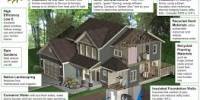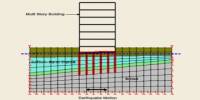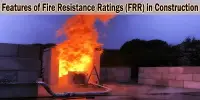Deflection, not strength, typically dictates the design of reinforced concrete beams and slabs. In this article, various strategies for reducing RCC beam and slab deflections are described. If these alternatives are effectively executed, the outcome might be more cost-effective than elements that either exhibit deflections and necessitate costly rehabilitation or members that are constructed to respond to superfluous deflections.
Designers must be aware of the level of stress in reinforced concrete members as well as whether or not the concrete has entirely cracked in order to evaluate these techniques fully. When applied moments in positive portions are greater than twice the cracking moments, the concrete members are regarded to be totally cracked.
Additionally, the effects of all alternatives on deflection are explored, as well as how much deflection may be reduced and how these methods can be used in the right circumstances. These options are broken down into three main groups, including design strategies, building processes, and material selection. This article discusses design alternatives for minimizing deflections.
Following are the design techniques to reduce deflections of reinforced concrete beams and slabs:
- Make the element deeper
- Make the member wider
- Introduce compression reinforcement
- Add tension reinforcement
- Apply or increase prestressing
- Revise geometry of the structure
- Review deflection limit criteria
Make the RCC Beams and Slabs Deeper
After an architectural design has been created, it may be difficult or impossible to change the dimensions of concrete components, however there are several circumstances in which raising beam depth is achievable. It is claimed that reducing deflection is approximately equal to the square of the effective depth (I = nAs (1-k) jd2 almost = d2) for cracked and nearly equal to the cube of the ratio of total depth (I = (bh3)/12 almost = h3) for uncracked sections.
Comparing uncracked rectangular sections to uncracked T-sections, increasing stiffness by increasing depth is more effective in rectangular sections. This is due to the fact that the flanges remain fixed, having a consistent influence on uncracked rigidity and not increasing proportionally with depth. The member stiffness will significantly rise if the depth of a section is increased to the point where it could result in a decrease in tensile stress, causing cracked sections to become partially cracked or uncracked. Lastly, the stiffness of uncracked element could be higher three times than the stiffness of partially cracked element.
Choose Wider Member Sections of RCC Beams
If the component is intact, expanding the section’s breadth will proportionally increase stiffness. However, extending the breadth of a cracked component will not result in a significant increase in the element’s stiffness unless the section becomes uncracked after doing so. This method cannot be used on slabs and members whose breadth is physically constrained. Nevertheless, when architectural factors preclude altering the beam height, the option is still applicable and notably effective for improving stiffness.
Introduce Compression Reinforcement to RCC Beams and Slabs
Adding compression bars as per ACI Code procedure will not influence immediate deflection but will half long term deflection. For instance, if long term and short term deflection of an element is 25 mm and 12 mm respectively, (total deflection is 37 mm), adding 2% compression reinforcement decline long term deflection by 50% means 12.5 mm and total deflection of the member will be 24.5 mm.
If compression steel reinforcement is placed close to the compression face, the effect will be greater, which is why deep beams benefit more from this technique than shallower beams or slabs do when both members have the same concrete cover. Although this choice is advantageous for all flexural members, it is particularly effective and advantageous for T-beams where the neural axis is close to the compression face.
Add Tension Reinforcement to RCC Beams and Slabs
Adding tension bars are considerably effective and nearly proportionally decrease deflection (immediate plus long term deflection) with increasing steels in fully cracked sections. Contrarily, the influence of adding tension steels on the deflection of an uncracked section is negligible.
For example, if the deflection of an element is 3.8 cm, it can be decreased to around 2.8 cm by adding fifty percent of tension reinforcement to the member. By adding tension steels, the maximum reinforcement limit advised by the ACI Code should not be exceeded. This technique has a considerable impact on slabs that are both solid and ribbed under reinforcement. For substantially reinforced beams, it is either not allowed or restricted unless compression steels are applied. Finally, congestion reinforcement is possible if it is decided to apply this technique.
Apply or Increase Prestressing
Since the majority of prestressed parts are made to balance applied loads, prestressed tendons’ upward reaction is about equal to that of dead and other continuous and permanent loads. Both prestressed and conventional reinforced concrete sections experience the same amount of deflection due to live loads. Less deflection from the live load will occur when prestressing prevents the element from cracking when it otherwise would.
Additionally, if the element’s size is reduced to apply prestressing, the deflection as a result of the live load will be very high. Because of this, the span to depth ratio of floor slabs and roofs is limited in the event of light living load to 48 and 52, respectively. To achieve desired deflection performance when the live load to dead load ratio is high, the span to depth ratio must be proportionately reduced.
Last but not least, it is not necessary to balance the entire dead load and the element may be partially cracked if the member is only prestressed to provide satisfactory deflection.
Revise Geometry of the Structure
This alternative could include making two-way systems by include cross elements, shortening spans by including more columns, and enlarging columns to provide stronger restraints for flexural members. The last choice is specifically influential in end spans.
Review Deflection Limit Criteria
If a member’s deflection exceeds the permitted deflection, it may be possible to adjust the deflection restrictions to determine whether they are excessively strict or not. Applying additional measures is not necessary if analysis and experience show that the deflection limitation criteria can be increased.
Most of building Code does not establish absolute limitations on deflections. The engineers must decide whether to apply the recommendations from the building codes in building occupancy or construction conditions.
















